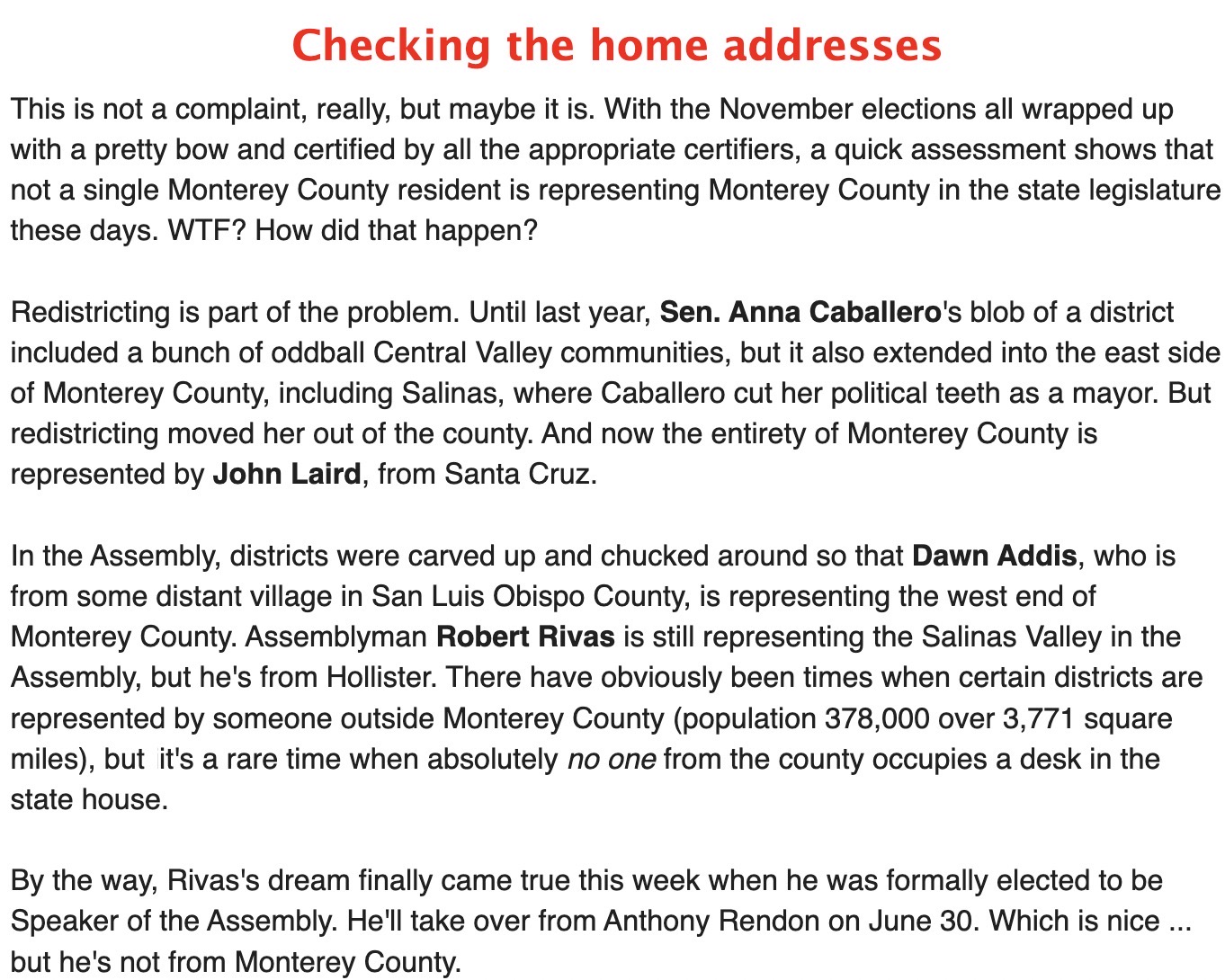| OPINION
By Juan Uranga
Voices of Monterey Bay recently noted that Monterey County no longer has a county resident representing it in the California state legislature. (See newsletter item below.) Given the political history of Monterey County, the lack of representation is a shame.
The shame is personal for me. When I arrived in the Salinas Valley in 1974 to serve as a farmworker attorney, most of the county was controlled by conservative Republicans. Politically, it seemed to me ruby red, especially in the Salinas Valley. And racially, it was lily white. In Salinas, Latinos were nowhere near the centers of power. Not at the county level, not at the municipal level, not at the school district level. With encouragement from Fred and Sam Farr, a group of us set out to change that profile. We succeeded. Today, Monterey County is politically as blue as the sky on a fogless Peninsula day and as brown as the rich soil that nurtures crops in the Salinas Valley.
For decades, legendary Monterey County political leaders including Fred Farr, Sam Farr, Simon Salinas and Anna Caballero provided strong, community-based leadership in Sacramento. (Editor’s note: the author is Caballero’s husband.) The recently completed redistricting process put an end to that. Monterey County now has a state senator who resides in Santa Cruz County and two assembly members, one who resides in San Benito County and a second who resides in San Luis Obispo County. What’s more, the member of congress who represents the Salinas Valley, the most populated part of Monterey County, now resides in the Silicon Valley.
Fortunately, the persons who currently hold those four offices are well positioned to give Monterey County good representation. But that does not undo the fact that Monterey County no longer has a resident representing it in the California State Senate nor in the California State Assembly. The same is true about the person who represents the great Salinas Valley in the United States House of Representatives. We need to be clear on how this happened and resolve to do better.
I have no quarrel with the California Redistricting Commission, the body tasked with taking public input and redrawing the lines. As much as we may wish for simple, straight boundary lines, that is mostly not achievable. Instead, we get curves and angles that look confusing. The Commission did its job given the information that it received.
I do, however, object to the input that some Latinos, both at the local level and at the statewide level, provided to the Commission. Their input resulted in a redistricting map that undid political gains that Latinos had achieved in the Salinas Valley and almost destroyed similar gains in the Central Valley. Those gains were achieved because the two valleys had a political connection to each other. The two valleys had been, for decades, joined together under the federal Voting Rights Act in order to give Latinos a political voice in both. Both Monterey County (Salinas Valley) and Merced County (Central Valley) were protected jurisdictions under Section 5 of the Voting Rights Act.
Some Latino leaders in both the Salinas Valley and the Central Valley were hell-bent on separating the two valleys.
Until recently when the U.S. Supreme Court invalidated Section 5, the two entities could not be separated unless proof was first shown, to the U.S. Department of Justice, that the separation would not result in a weakening of Latino voting power. Unfortunately, some Latino leaders in both the Salinas Valley and the Central Valley were hell-bent on separating the two valleys, and they so advocated during the 2022 redistricting process.
Before this round of redistricting, the 12th Senate District included the Salinas Valley and a substantial part of the Central Valley. In fact, the Central Valley composed 60% of the district. In 2018, Anna Caballero won an overwhelming part of the Salinas vote and enough of the Central Valley vote to win the district. It was the first time a Democrat had won that district in 24 years. It was also the first time that a Latino (Caballero) occupied the seat. In the same election, a neighboring Central Valley district was won by a Latino, Sen. Melissa Hurtado. The combination of the two districts gave Democrats and Latinos a solid base in the Central Valley.
In the 2022 redistricting hearings, the redistricting map championed by some Latino activists in both valleys placed the Salinas Valley in a state senate district currently held by a non-Latino Senator. It also initially pitted the two incumbent Latinas (Caballero and Hurtado) against each other. Moreover, the new senate district that includes the Salinas Valley changed from one where Latinos comprised over 50% of the citizens voting age population to one where Latinos represent less than 30%. In the Central Valley, the reconfigured senate districts reduced a formerly secure Latino senate district (Hurtado’s) into one where, in 2022, Hurtado won by only 20 (yes, twenty) votes, making the district totally vulnerable to conservative, Anglo Republicans. (Caballero, even without the Salinas Valley vote, coasted to victory in 2022 in her part of the Central Valley, winning by 12.5 percentage points).
Latinos in the Salinas Valley endured decades of political struggle in order to make us, and Latinos in other rural California communities, actors in state politics. At times, the strife led to what I call, “The Latino Wars” with two Latino camps vying against each other. Even then, all Latino activists were focused on the same goal: political districts that carved a straight line to Latino political clout. That goal seems to have changed. The straight line has become an obtuse angle.
Enlarge

Have something to say about this story? Send us a letter or leave a comment below.